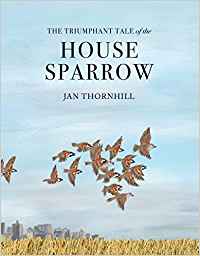| ________________
CM . . . . Volume XXIV Number 26. . . . March 9, 2018
excerpt:
How do you make something so ordinary we rarely pay attention to it the star of a narrative full of fascinating details? With excellent research and storytelling skills, that’s how. Author/illustrator Jan Thornhill has used both to create this intriguing historical account of a little bird few might realize has thrived for thousands of years in a fast changing world. As you read this book, you’ll be amazed at the adaptability of the common House Sparrow and perhaps choose to afford it more respect. Around 12,000 years ago, ancestors of this bird linked their fortunes with humans, and the species has never looked back. Our agricultural practices gave it food, our architecture gave it lodging, our explorations gave it transport throughout Europe, and immigrants eventually brought it to North America. Able to multiply rapidly, it soon became a pest. Efforts to control it have followed the bird throughout its history, but they were only partially successful. When the nature of human habitation, transportation and agricultural practices evolved in ways that presented significant obstacles for the sparrow, population numbers dropped. But its skill at adaptation may yet overcome these challenges so that, as the author suggests, it will always find a place among us. The book includes a map to show the origin and spread of the bird, a Life Cycle diagram, a brief Glossary and lists of Resources. Most interesting, though, is a lengthy list of other “Wild Animals that Choose to Live with Us”, everything from bedbugs to raccoons, clothing moths to coyotes. Thornhill uses an inviting conversational style as she weaves the chronological account, beginning with her finger solidly on our emotional response to this bird: “You know the one…..that boldly hops about on sidewalks….that chirps monotonously and loudly...” We’re set up immediately to wonder what could be so interesting about this unwelcome bird. Curiosity aroused, we’re drawn into the tale with details of how its early ancestors gave up migration to take advantage of farming—a year round source of grains and seeds—and nesting cavities in our buildings. The environment it found so appealing in Europe was duplicated in North America; even the abundance of horse power was a boon as the manure held plenty of seeds. In every modern urban setting, the sparrow has easily found its basic needs among people. Interspersed through the story are details of ways we have tried to eradicate this sparrow. Because it is a prolific breeder of up to 25 young each nesting season, it seems the bird earned the reputation as a pest even back in Ancient Egypt. Readers will be fascinated to learn about falcon mummies found with remains of the sparrow in their stomach, and that sparrow pie recipes used “meat from at least five dozen birds.” The bird is seen by many as messy, noisy and an invasive species that out competes other small native birds. In China, in 1958, war was declared on a closely related sparrow that attacked crops, and everyone killed as many as possible….until few remained to eat the insects that plagued crops. Of course, there is always another side to such a story. The author balances these discouraging facts by describing how, in China, the decimation of sparrows likely contributed to crop failures and starvation. We learn that the bird offers other benefits besides insect control; many find it cheerful and entertaining. It scavenges among the food we toss out. Perhaps of more import, should we be more alert to causes of the sparrows’ decline that may have implications for the health of our environment? Consider how adaptable the sparrow continues to be—nesting on traffic lights and store signs, learning to catch insects attracted by artificial lights, putting cigarette butts in its nest to control parasites, and even triggering motion sensors to open doors to malls and airports. Who knew all this about a rather nondescript bird that can make its home so readily among us and still often go unnoticed? Thought provoking, the book will leave readers curious about the adaptability of other animals with which we share the Earth. Appealing illustrations fill this quite large sized picture story book, with realistic House Sparrows fluttering on every page as they do so many places in our daily lives. Digitally rendered in precise detail, it is impossible to distinguish them from paintings or drawings. It will make a good addition to the collection of anyone drawn to study natural history. The Triumphant Tale of the House Sparrow is a fine companion book to Thornhill’s previous award winner, The Tragic Tale of the Great Auk. Highly Recommended. Gillian Richardson is a freelance writer living in BC.
Next Review |
Table of Contents for This Issue
- March 9, 2018. |
